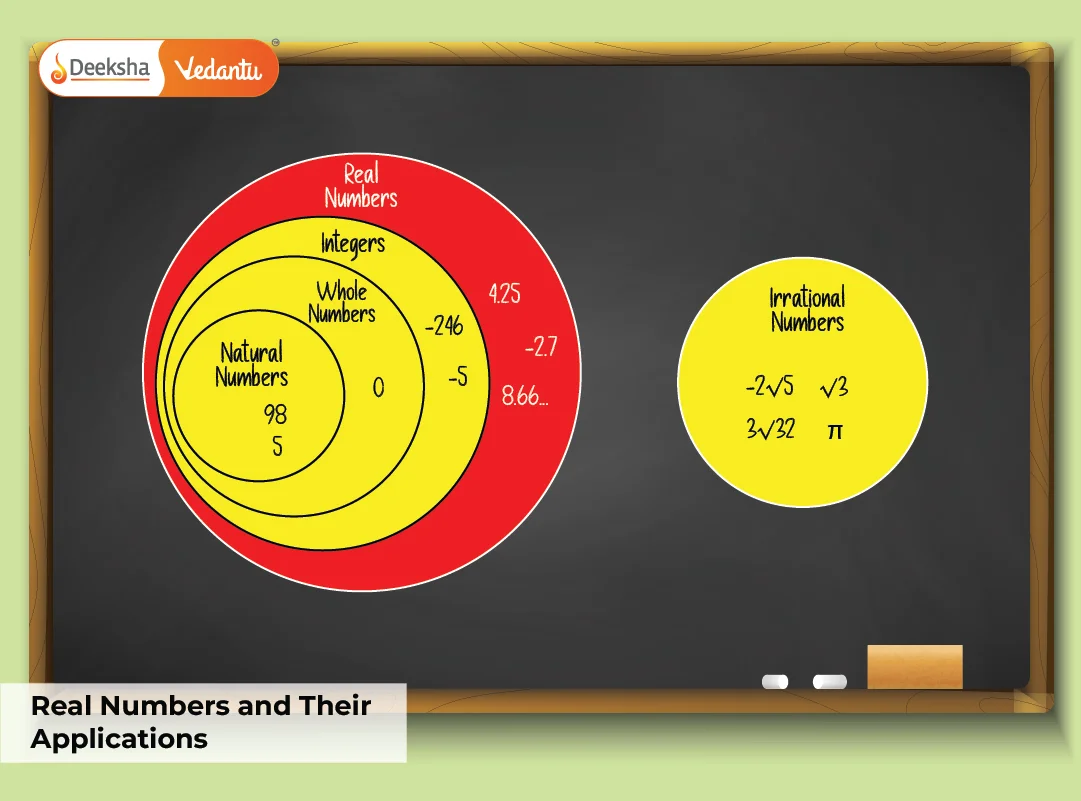Real numbers are the backbone of modern mathematics. From basic arithmetic to advanced calculus, they form the foundation of numerous concepts used in daily life, science, technology, and engineering. The real number system encompasses all numbers that can be located on a number line—whole numbers, integers, rational numbers, and irrational numbers.
This blog provides a detailed explanation of:
- What real numbers are (focus on Class 10 syllabus)
- The classification of real numbers
- The properties of real numbers
- Key theorems like the Fundamental Theorem of Arithmetic
- The concept of sets and how they relate to the real number system
- Common applications of real numbers in real-life contexts
Whether you’re preparing for exams or trying to relate classroom concepts to practical situations, this article will give you everything you need to master real numbers.
What Are Real Numbers?
In mathematics, real numbers refer to all numbers that can be plotted on a number line. They include both rational and irrational numbers, and therefore represent a comprehensive numerical system.
Let’s break down the types of numbers included in the real number system:
- Natural Numbers: 1, 2, 3, 4, …
- Whole Numbers: 0, 1, 2, 3, …
- Integers: …, -3, -2, -1, 0, 1, 2, 3, …
- Rational Numbers: Numbers expressed as p/q where q ≠ 0
- Irrational Numbers: Non-repeating, non-terminating decimals like √2, π
Thus, we write:
Real Numbers = Rational Numbers ∪ Irrational Numbers
All real numbers can be located on the number line and used for comparing quantities, performing arithmetic, or solving equations.
🔗 Explore more on real numbers here: https://deekshalearning.com/maths/real-numbers/
Real Number Classification
The real number system can be visualized as a hierarchy:
| Category | Description | Examples |
| Natural Numbers | Counting numbers | 1, 2, 3, … |
| Whole Numbers | Natural numbers plus zero | 0, 1, 2, 3, … |
| Integers | All whole numbers including negatives | -5, 0, 6 |
| Rational Numbers | Expressible as p/q | 3/4, -2.5, 0.6 |
| Irrational Numbers | Not expressible as p/q | π, √2, e |
Real numbers can be either terminating decimals, repeating decimals (rational), or non-repeating non-terminating decimals (irrational).
🔗 Revisit irrational numbers in detail: https://deekshalearning.com/maths/revisiting-irrational-numbers/
🔗 Understand rational numbers: https://deekshalearning.com/maths/rational-numbers/
Properties of Real Numbers
1. Closure Property
Real numbers are closed under addition and multiplication:
a + b ∈ R, a × b ∈ R
2. Commutative Property
Changing the order of operands does not affect the result:
a + b = b + a, a × b = b × a
3. Associative Property
Grouping of numbers does not change the result:
(a + b) + c = a + (b + c), (a × b) × c = a × (b × c)
4. Distributive Property
a × (b + c) = a × b + a × c
5. Identity Elements
- Additive identity = 0 → a + 0 = a
- Multiplicative identity = 1 → a × 1 = a
6. Inverse Elements
- Additive inverse of a: a + (-a) = 0
- Multiplicative inverse of a (where a ≠ 0): a × (1/a) = 1
These properties form the algebraic rules that govern how real numbers behave.
Fundamental Theorem of Arithmetic
The Fundamental Theorem of Arithmetic states:
Every composite number can be uniquely expressed as a product of prime numbers (excluding the order).
🔗 Learn the Fundamental Theorem of Arithmetic: https://deekshalearning.com/maths/the-fundamental-theorem-of-arithmetic/
Example:
120 = 2³ × 3 × 5
This prime factorization is unique and essential in simplifying fractions, finding HCF/LCM, and solving many algebraic problems.
Sets and Real Numbers
In mathematics, sets are used to group numbers under common characteristics. The real numbers form a universal set when studying numeric operations.
🔗 Understand sets and their operations: https://deekshalearning.com/maths/sets/
- R: Real numbers
- N ⊂ W ⊂ Z ⊂ Q ⊂ R
Set theory helps visualize relationships, perform unions or intersections, and classify numbers more clearly.
Applications of Real Numbers
1. Banking and Finance
- Calculating interest (simple and compound)
- Currency exchange rates
- Monthly budgeting and taxes
- Loan EMIs and investment growth
2. Construction and Architecture
- Use of irrational numbers like π and √2 in measurements
- Ensuring symmetry, angles, and dimensions
- Estimating materials based on area and volume
3. Physics and Engineering
- Velocity, force, resistance, and energy calculations
- Equations of motion and projectile trajectories
- Use of real values in units like Joules, Newtons, etc.
4. Medicine and Biology
- Body mass index (BMI), blood pressure range
- Concentration of medicines, dosages
- Statistical analysis in research
5. Data Science and Technology
- Real numbers used in machine learning and AI algorithms
- Data normalization, regression, and statistical modeling
6. Daily Scenarios
- Grocery bills and discounts (₹49.99)
- Fuel prices (₹102.75/litre)
- Cooking measurements (1.5 cups, 0.75 tsp)
- Fitness tracking (5.6 km, 120.8 bpm)
Real numbers are practical tools that make everyday decisions logical and quantifiable.
Sample Problem
- Determine if √75 is rational or irrational.
Solution:
√75 = √(25 × 3) = 5√3
√3 is irrational → So 5√3 is irrational.
Answer: Irrational
FAQs
Q1. What is the primary difference between rational and irrational numbers?
Rational numbers can be written as fractions; irrational numbers cannot be expressed as p/q.
Q2. Can real numbers be negative?
Yes. Real numbers include both positive and negative values.
Q3. Are all real numbers decimals?
Not necessarily. Real numbers include whole numbers, integers, decimals, and fractions.
Q4. What are some examples of irrational numbers?
π, √2, e, and φ (Golden Ratio)
Q5. Is every rational number a real number?
Yes. Rational numbers are a subset of real numbers.
Q6. How are real numbers used in Class 10 exams?
They appear in number systems, coordinate geometry, algebra, statistics, and trigonometry.
Q7. Can two irrational numbers add up to a rational number?
Yes, for example: √2 + (-√2) = 0
Conclusion
Real numbers are more than symbols—they represent quantities, change, relationships, and predictions. Understanding the real number system helps you grasp math deeply and prepares you for real-world problem-solving.
Table of Contents










Get Social